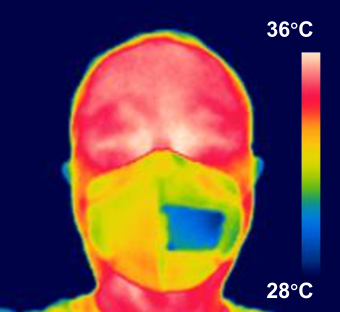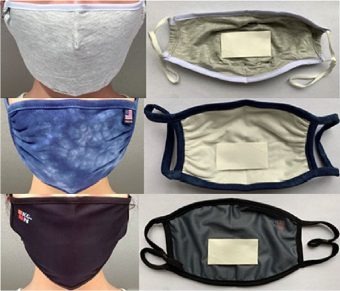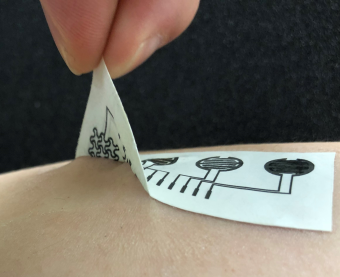
June 27, 2022
Contact: Eric Stann, 573-882-3346, StannE@missouri.edu
For years, automotive companies have developed intelligent sensors to provide real-time monitoring of a vehicle’s health, including engine oil pressure, tire pressure and air-fuel mixture. Together, these sensors can provide an early warning system for a driver to identify a potential problem before it may need to be repaired.
Now, in a similar vein biologically, Zheng Yan, an assistant professor in the MU College of Engineering at the University of Missouri, has recently published two studies demonstrating different ways to improve wearable bioelectronic devices and materials to provide better real-time monitoring of a person’s health, including vital signs.
Developing a ‘smart’ face mask
The onset of the COVID-19 pandemic has brought the idea of mask-wearing to the forefront of many people’s minds. In response, one focus of Yan’s lab has been to develop breathable soft bioelectronics. He said it was natural for him and his team to come up with the idea for integrating bioelectronics in a breathable face mask, which can monitor someone’s physiological status based on the nature of the person’s cough. Their findings were recently published in ACS Nano, a journal of the American Chemical Society.

“Different respiratory problems lead to different cough frequencies and degrees,” Yan said. “Taking chronic obstructive pulmonary disease (COPD) as an example, the frequency of cough in the early morning is higher than that in the daytime and night. Our smart face mask can effectively monitor cough frequencies, which may assist physicians with knowing disease development and providing timely, customized interventions.”
In addition to monitoring someone’s physiological status, the mask can also help identify proper mask wearing in public places using a bioelectronic sensor, Yan said. At this time, the mask does not have the capability to provide automatic reminders, but they would like to develop that function in the future.
Laser-assisted fabrication of wearable electronics
For a decade, scientists have been utilizing a laser-assisted fabrication approach, but Yan said one area that could still benefit from this approach is in building wearable bioelectronics.
“Laser-assisted fabrication is simple, scalable, cost-effective and easily customizable,” Yan said. “This can lower the cost of wearable electronics and benefit both their practical, one-time use and personalization by providing customized devices for health care applications.”

In a recent study published in Science Advances, a journal of the American Association for the Advancement of Science (AAAS), Yan and his team studied the potential of using a metallic conductor called MoO2.
“It exhibits high electrical conductivity, chemical stability, MRI-compatibility and biocompatibility, which is well suitable for construction of various bioelectronic sensors and stimulators,” Yan said.
Yan said one potential application of this approach could be to help monitor a person’s breathing.
“Monitoring a person’s breathing rhythm will be useful for diagnosis of some diseases, such as sleep apnea,” Yan said. “Also, we could concurrently monitor the heart rate, heart rate variation and electroencephalograms to provide more comprehensive information for the study of sleep apnea.”
“A Breathable, Reusable, and Zero-Power Smart Face Mask for Wireless Cough and Mask-Wearing Monitoring,” was published in ACS Nano. Other authors include Yun Ling, Yadong Xu at MU: Pai-Yen Chen, Zhilu Ye, Minye Yang and Liang Zhu at University of Illinois at Chicago. Funding was provided by grants from the National Science Foundation (ECCS-1914420 and CMMI-2045101). The content is solely the responsibility of the authors and does not necessarily represent the official views of the funding agencies.

“Laser-Scribed Conductive, Photoactive Transition Metal Oxide on Soft Elastomers for Janus On-Skin Electronics and Soft Actuators,” was published in Science Advances. Other authors include Ganggang Zhao, Yun Ling, Zanyu Chen, Cherian J. Mathai, Ogheneobarome Emeje, Alexander Brown, Xaioqing He, David Stalla, Yadong Xu, Zehua Chen and Shubhra Gangopadhyay, at MU; Yajuan Su and Jingwei Xie at University of Nebraska Medical Center; Dinesh Reddy Alla and Jie Huang at Missouri University of Science and Technology; Chan Song Kim and Qian Chen at University of Illinois at Urbana-Champaign; and Pai-Yen Chen at University of Illinois at Chicago.
Funding was provided by startup funds and an EM Excellence Award from the University of Missouri; grants from the National Science Foundation (1917630 and 2045101); startup funds from the University of Nebraska Medical Center and grants from the National Institute of General Medical Science of National Institutes of Health (R01GM123081 and R01GM138552). The content is solely the responsibility of the authors and does not necessarily represent the official views of the funding agencies.
Editor’s Note:
Yan is an assistant professor in the Department of Biomedical, Biological and Chemical Engineering as well as the Department of Mechanical and Aerospace Engineering.
Visit the MU College of Engineering to learn how the college is celebrating its 150th anniversary in 2022.



